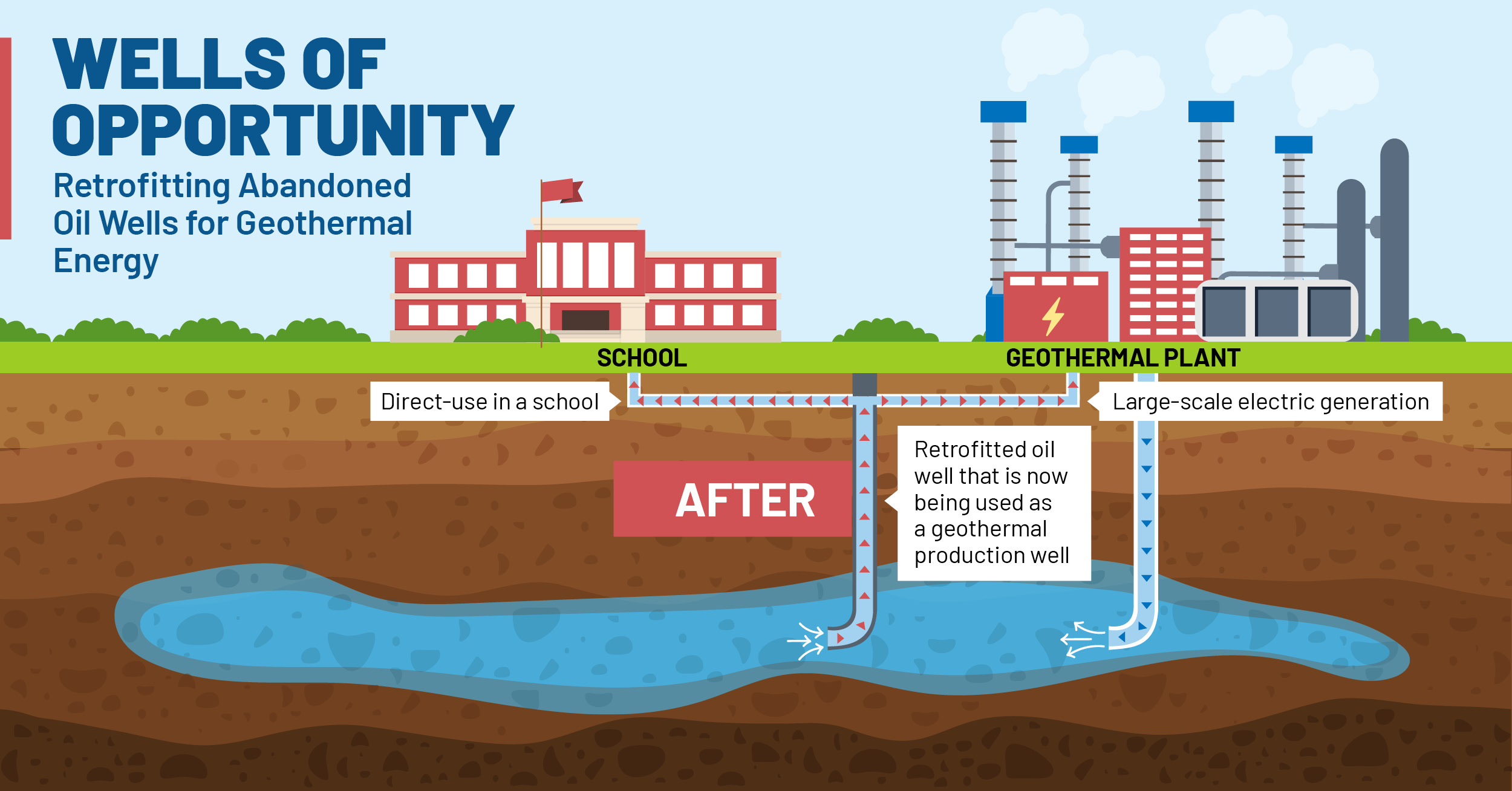
A key step to unlocking the full potential of reliable, domestic geothermal energy may lie inside millions of American oil and gas wells.
These wells can be used to harness geothermal energy in two ways: through the retrofitting of inactive or unproductive wells, or through co-production on active wells.
In well retrofits, an unused, dry, or unproductive oil and gas well first undergoes any repairs necessary for safe operation. Water is then pumped into the oil and gas well, where it is warmed by the earth and drawn back to the surface to power a thermoelectric generator. The hot water pulled to the surface can be used for heating, cooling, or to power nearby structures and homes. America has millions of dry or unproductive oil and gas wells, many of which could be retrofitted for geothermal use.
Note: The scope of GTO’s WOO initiative specifically targets inactive or unproductive wells. These wells may include those that qualify as abandoned according to the U.S. Environmental Protection Agency: wells that have been plugged to prevent migration of gas or fluids, wells with no recent production that are not plugged, and wells with no recent production and no responsible operator.
Co-production creates geothermal energy from oil and gas wells that are still active. Oil and gas wells often encounter extremely hot water, and co-production captures that heat to generate electricity. Because the water is continuously recycled by injecting it back into the reservoir, co-production can create wells that produce two types of energy simultaneously. Even when subsurface temperatures are not hot enough for electricity production, geothermal energy can be tapped for direct uses like industrial processes and heating and cooling of greenhouses and other buildings.
Wells of Opportunity (WOO) Initiative
Geothermal energy from retrofitted oil wells can be tapped for electricity production as well as direct use applications like heating and cooling of schools, greenhouses, and other buildings.
The Geothermal Technologies Office (GTO) is exploring both well retrofitting and co-production with the Wells of Opportunity (WOO) initiative. This initiative’s funding opportunity was released with two topics—Amplify: EGS Near-Field RD&D, and ReAmplify: Geothermal Production from Hydrocarbon Wells—and an update to this initiative was released in July 2021. The initiative will help establish the commercial viability of geothermal energy production from existing hydrocarbon fields through a number of projects:
Harvest waste heat from existing oil and gas wells in Texas to generate commercial quantities of geothermal electricity.
Produce electricity from 11 existing oil and gas wells in California’s San Joaquin Valley using an innovative power generation technology.
Sequentially stimulate three wells at three separate operating geothermal fields in Nevada to conduct a comparative analysis of similar stimulations in different geologic environments and increase production: Don A. Campbell well 68-1RD in Mineral County; Jersey Valley well 14-34 in Pershing County; Tungsten Mountain well 24-22 in Churchill County.
Install state-of-the-art, American-made geothermal heat engines at Blackburn Oilfield in Nevada for electrical power production. As a result of the project, Transitional Energy will generate geothermal energy at the site and construct new rural electric vehicle charging infrastructure.
Produce heat from an Oklahoma oilfield for use in Tuttle Elementary and Middle Schools in Tuttle, Oklahoma. With access to four hydrocarbon wells within a mile, the schools will benefit from the "recycling" of oil and gas infrastructure at considerable savings for the schools.
These projects will expand U.S. geothermal energy capabilities and ultimately create jobs, providing opportunities for oil and gas workers.
WOO Successes
The WOO initiative has realized several successes in leveraging oil and gas wells to harness geothermal energy.
The University of Oklahoma WOO project in Tuttle secured the first permit in the state to convert oil and gas wells for geothermal purposes and has started activities to repair and restore the wells. This progress paves the way for future geothermal development in Oklahoma by establishing a precedent for these types of wells and provides an example for other states or jurisdictions to learn from when designing and implementing processes.
The Geothermix field project in Navidad Resources’ Austin Chalk wells (Texas) has demonstrated successful construction and lab scale testing of Geothermix’s novel thermoelectric generation cells. These cells could allow for power generation from a variety of fluids on the lower end of the temperature spectrum, including excess heat from oil and gas production, thus converting heat that would otherwise be wasted into usable electricity.
Gradient Geothermal (formerly Transitional Energy) has completed their Phase 1 feasibility study, confirmed the viability of power generation potential at the Blackburn oil field in Nevada, and worked successfully with the U.S. Department of the Interior’s Bureau of Land Management (BLM) to secure the required lease and approvals, providing a pathway for approvals on future oil and gas well conversions on BLM leases.
WOO is part of GTO’s Enhanced Geothermal Systems (EGS) Program. Learn more about other EGS efforts and GTO priorities.
GTO emails bring geothermal funding opportunities, events, publications, & activities directly to your inbox.



